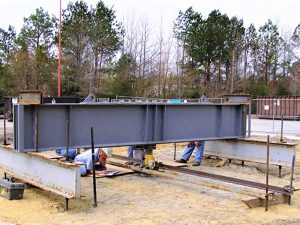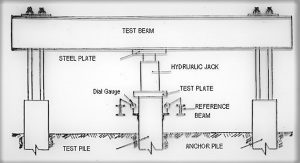Helical piles, or helical piers, offer maximum benefits structurally when loaded either in tension or compression. In certain design instances, the helical piles may be needed to carry lateral loads and it is important to confirm their lateral load capacity before construction. Heavier loads that might require testing may include support for platforms for telephone poles, foundations for light poles, large road signs or use as foundation systems for homes.
The Testing Process
To begin testing, a helical pile will be driven into the ground and a thrust block will be cast around the pile to keep it from leaning. The pile is then covered with a PVC pipe wrapped in a lining and greased. This is so the pile doesn’t stick to the casting. The helical pile is then cut to the height of the PVC pipe.
A metal plate is placed on top of the pile to create an even center for pressure. Beams are placed on top of the plate; they will be used to push down on the pile. Reaction anchors are screwed into the ground and over the beams to hold them in place.
A 100 ton jack hammer is then started to apply heavy hits to the beams to see if the pile below can take the blows. Two gauges are operating on either side of the beams to record the pressure the hammer’s hits are enforcing. They also measure whether the pile is working independently and not getting support from the other elements of the test. The information is then recorded and the test is concluded.


